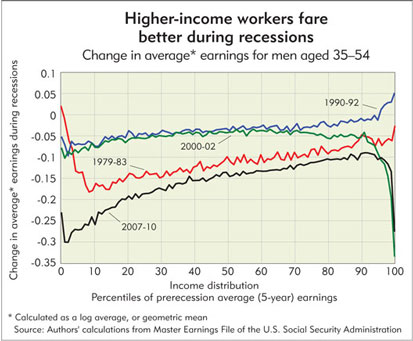What will happen to your income in the next recession? Will it fall because you lost your job or had to take a pay cut? Or could you be among those who thrive despite the downturn, seeing their earnings rise? Recent research by a trio of labor economists, including Fatih Guvenen, a Minneapolis Fed visiting scholar and an associate professor of economics at the University of Minnesota, tries to answer those questions.

Fatih Guvenen
Photo by Steve Niedorf
“The Nature of Countercyclical Income Risk” (Minneapolis Fed Staff Report 476) investigates changes in earnings experienced by U.S. workers over the business cycle, from expansion to recession. Joining Guvenen in the study are Federal Reserve Board economist Serdar Ozkan and Jae Song, a senior researcher with the U.S. Social Security Administration.
Using Social Security data to chart the earnings of U.S. men over a 33-year period, the economists find that workers’ changing fortunes during recessions are linked to their prerecession earnings. On average, the earning power of low-income workers erodes most during the downturn, while higher-income workers fare better—except, surprisingly, the top 1 percent of earners. The paper also upends some long-standing assumptions about the nature of earnings change during recessions.
How the distribution of income changes during recessions has long fascinated economists. The earnings risks faced by workers when economic output falters—whose earnings are likely to drop, whose are likely to remain stable and even rise—shape the fortunes of tens of millions of households. Recessionary income change also is related to income inequality.
“All labor economists are interested in income risk; that’s their starting point,” said Guvenen in an interview. “But how do we measure that risk?” Indeed, quantifying income risk—the probability of earnings rising or falling, and by how much—has long proven problematic. Lacking hard data on income changes in the U.S. workforce over time, economists have traditionally used theory to infer changes in income distribution over the business cycle.
Guvenen, Ozkan and Song break new ground by taking an empirical approach to gauging earnings risk. The researchers employ a massive data set—a random sample of Social Security records containing the earning histories of over 5 million U.S. men—to examine workers’ changing incomes as they weathered four recessions between 1980 and 2010. (Women are excluded because their rising workforce participation during the study period would have made the data more difficult to interpret.)
The wages of income loss
During the Great Recession, the labor earnings of U.S. men fell an average of 6.5 percent—the sharpest decline of any recession since the 1930s. But that figure obscures wide variation across the workforce; while some workers experienced severe declines in their pay, others saw more modest income losses, while earnings actually rose for some.
Could those outcomes have been foreseen, based on the characteristics of workers evident in the Social Security records? To find out, the economists analyze recessionary earnings change, comparing the experiences of prime-age (35 to 54) workers with different levels of prerecession earnings. In fact, “the pre-episode average earnings level turns out to be an excellent predictor of a worker’s earnings growth” for the last recession and three previous downturns, they write.
For most of the workforce, income loss during a recession decreases proportionally with earnings before the downturn (see chart). During the last recession, the incomes of workers in the 10th percentile of the prerecession earnings distribution fell about 18 percent more than those of workers in the 90th percentile. The implication is that janitors and fast-food workers fare worse in recessions than office managers or engineers. Thus, income inequality increases in recessions: Lower-income workers on average sustain greater earnings losses than the majority of workers with moderate or high incomes.
What is a surprise is the travails of very-high-income workers—the proverbial and literal 1 percent—in recent economic downturns. As the chart shows, people at the top of the earnings distribution saw their incomes nosedive during the Great Recession and 2001–02 contraction. “During the last two recessions, high-income workers experienced enormous and persistent earnings losses … which dwarf the losses of individuals even with slightly lower earnings,” the authors write. This fate is confined to the very top: Even those in the upper 2 percent to 5 percent don’t share their misfortune.
They don’t explain this reversal of fortunes from earlier recessions, when one percenters did better on average than anyone else in the workforce. But Guvenen offers one possibility: Over the past two decades, industries employing high-income workers—finance and real estate, for example—have become more cyclical, with bigger earnings losses during recessions and larger gains in expansions.
Random slings and arrows
A large body of previous research has indicated that increased income inequality during recessions can stem from increased income variance—a spreading out of the overall earnings distribution. Economists have long assumed that during recessions stronger positive as well as negative shocks to income widen the range of earnings changes. Most income dynamics models developed over the past 30 years are based on the premise that income variance due to this random (“idiosyncratic”) component of income risk is countercyclical—it increases during downturns.
In contrast, Guvenen, Ozkan and Song find that income variance is not countercyclical—and therefore doesn’t contribute to earnings inequality. Rather, large income changes become more negative than positive in downturns, leaving overall variance unchanged. Most U.S. workers experience little change in their earnings over the business cycle. But for workers at every earnings level, the chance of getting a big raise diminishes during economic contractions, while the risk of a large pay cut or layoff increases.
Conclude the authors: “Relative to the earlier literature that argued for increasing variance—which results in some individuals receiving larger positive shocks during recessions—our results are even more pessimistic: Uncertainty increases in recessions without an increasing chance of upward movements.”
Guvenen and other researchers continue to plumb Social Security records for further insights into the anatomy of income change. For example, Guvenen and Song are studying the top 1 percent of earners, looking for patterns over their working lives that set them apart from other workers.






